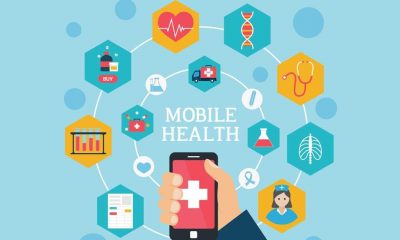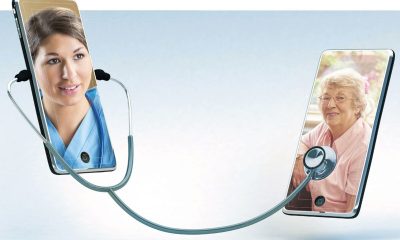health
New Trends in Women’s Health and Reproductive Medicine

In the rapidly evolving field of women’s health and reproductive medicine, several new trends are emerging that are shaping the way healthcare is delivered to women. These trends are driven by advancements in technology, a deeper understanding of female physiology, and a growing emphasis on personalized care. This article explores some of the most significant trends in women’s health and reproductive medicine, highlighting their potential impact on women’s well-being.
Personalized Medicine and Genomics
One of the most promising trends in women’s health is the rise of personalized medicine, which tailors medical treatment to the individual characteristics of each patient. This approach is particularly relevant in reproductive medicine, where genetic factors play a crucial role in fertility and pregnancy outcomes. Advances in genomics have enabled healthcare providers to identify genetic markers associated with various reproductive disorders, such as polycystic ovary syndrome (PCOS) and endometriosis.
By analyzing a woman’s genetic profile, doctors can develop personalized treatment plans that optimize her chances of conceiving and carrying a healthy pregnancy to term. For example, genetic testing can identify mutations in the BRCA1 and BRCA2 genes, which are linked to a higher risk of breast and ovarian cancer. Women with these mutations can receive tailored screening and preventive measures to reduce their risk.
Telemedicine and Remote Monitoring
Telemedicine has become an indispensable tool in women’s health, particularly in the wake of the COVID-19 pandemic. This technology allows women to access healthcare services from the comfort of their homes, reducing the need for in-person visits. Telemedicine is especially valuable for women living in rural or underserved areas, where access to specialized healthcare providers may be limited.
Remote monitoring devices, such as wearable sensors and mobile apps, are also gaining traction in women’s health. These tools enable continuous tracking of vital signs, menstrual cycles, and other health parameters. For instance, wearable devices can monitor a woman’s heart rate, sleep patterns, and physical activity, providing valuable data that can inform her healthcare decisions.

Picture by: Yandex.com
Fertility Preservation and Assisted Reproductive Technologies
Fertility preservation is an increasingly important aspect of reproductive medicine, as more women delay childbearing for personal or professional reasons. Techniques such as egg freezing and ovarian tissue cryopreservation offer women the opportunity to preserve their fertility and have children later in life. These options are also beneficial for women undergoing medical treatments, such as chemotherapy, that may affect their reproductive health.
Assisted reproductive technologies (ART) continue to advance, offering new hope to couples struggling with infertility. In vitro fertilization (IVF) remains the most well-known ART, but other techniques, such as intracytoplasmic sperm injection (ICSI) and preimplantation genetic testing (PGT), are also making significant strides. PGT, for example, allows for the screening of embryos for genetic abnormalities before implantation, increasing the chances of a successful pregnancy.
Hormone Replacement Therapy and Menopause Management
Menopause is a natural phase in a woman’s life, but it can bring about various symptoms that affect her quality of life, such as hot flashes, night sweats, and mood swings. Hormone replacement therapy (HRT) has long been a treatment option for managing menopausal symptoms, but recent trends are focusing on more personalized and safer approaches.
Bioidentical hormone therapy (BHT) is gaining popularity as an alternative to traditional HRT. BHT uses hormones that are chemically identical to those produced by the human body, which may reduce the risk of side effects. Additionally, healthcare providers are increasingly using individualized dosing and delivery methods, such as transdermal patches and gels, to optimize the effectiveness of HRT.
Mental Health and Holistic Approaches
Mental health is an integral part of women’s overall well-being, and there is a growing recognition of the need for holistic approaches to healthcare. Conditions such as anxiety, depression, and postpartum depression are prevalent among women, and addressing these issues requires a comprehensive approach that considers both physical and emotional health.
Integrative medicine, which combines conventional medical treatments with complementary therapies, is gaining traction in women’s health. Practices such as acupuncture, yoga, and mindfulness meditation are being incorporated into treatment plans to address the mind-body connection. These holistic approaches can help women manage stress, improve mental health, and enhance their overall quality of life.
Advances in Gynecological Surgery
Minimally invasive surgical techniques are revolutionizing gynecological surgery, offering women less invasive options for treating various conditions. Laparoscopic and robotic-assisted surgeries are becoming the standard of care for procedures such as hysterectomies, myomectomies (removal of fibroids), and endometriosis excision.
These advanced surgical techniques offer several benefits, including smaller incisions, reduced pain, shorter recovery times, and lower risk of complications. As a result, women can return to their normal activities more quickly and with fewer disruptions to their lives.
Preventive Health and Wellness
Preventive health measures are essential for maintaining women’s health and preventing chronic diseases. There is a growing emphasis on lifestyle interventions, such as nutrition, exercise, and stress management, to promote overall wellness. Healthcare providers are increasingly focusing on educating women about the importance of regular screenings, such as mammograms and Pap smears, to detect potential health issues early.
In addition, public health initiatives are targeting specific populations of women to address disparities in healthcare access and outcomes. Efforts to improve maternal health, reduce rates of sexually transmitted infections (STIs), and promote vaccination against human papillomavirus (HPV) are critical components of preventive health strategies.
Conclusion
The field of women’s health and reproductive medicine is undergoing significant transformations, driven by advancements in technology, personalized medicine, and a holistic approach to care. These new trends are enhancing the quality of healthcare for women, providing them with more options and better outcomes. As these trends continue to evolve, they hold the promise of improving the well-being of women across the globe, empowering them to lead healthier and more fulfilling lives.
health
Transformers Market Trends, Size, and Technology Analysis by 2035

Introduction
The Global Transformers Market Report is a comprehensive report on the Transformers market, offering key insights on business strategies, current trends, and presenting qualitative and quantitative analysis of the Transformers market. This report offers in-depth research insights on key and significant aspects of the Transformers market, providing an in-depth analysis of key drivers, restraints, restraints, growth prospects, threats, and risks. The report also includes an in-depth analysis of the competitive landscape and regional scope of the Transformers market.
The global Transformers market report employs an extremely extensive and perceptive process that analyzes statistical data relating to services and products offered in the market. The research study is a pivotal document in understanding the needs and wants of the clients. The report is comprised of significant data about the leading companies and their marketing strategies. The Transformers industry is witnessing an expansion and change of dynamics owing to the entry of several new players.
The study outlines the rapidly evolving and growing market segments along with valuable insights into each element of the industry. The industry has witnessed the entry of several new players, and the report aims to deliver insightful information about their transition and growth in the market. Mergers, acquisitions, partnerships, agreements, product launches, and joint ventures are all outlined in the report.
Market Size and Growth Projections for Transformers
The global transformers market has been steadily growing in recent years, driven by the increasing demand for electricity and the rise of renewable energy sources. According to market research, the global transformer market was valued at approximately USD 80 billion in 2022 and is expected to grow at a compound annual growth rate (CAGR) of 6-8% through 2035.
Factors Driving Market Growth:
- Rising Demand for Electricity: As urbanization continues, the need for reliable electrical infrastructure increases. Cities are expanding, and industries are growing, which requires more electricity and thus, more transformers to ensure the stable distribution of power.
- Renewable Energy Integration: The world is transitioning toward renewable energy sources like solar and wind, which require specialized transformers to integrate renewable power into the grid. With this shift, transformers will play an even more important role in managing energy distribution and maintaining grid stability.
- Infrastructure Upgrades: In developed nations, a major portion of the power grid infrastructure is aging and in need of replacement. This is pushing a wave of modernization and demand for new transformers, especially those that are more efficient and capable of handling fluctuating power loads.
- Electric Vehicles (EVs) and Charging Infrastructure: The electric vehicle market is growing at a rapid pace. This demand for EVs necessitates the installation of more charging stations, each requiring transformers for proper operation. This is another driving force for the market’s expansion.
Key Companies Profiled in the Report are
- ABB
- Alstom
- Bharat Heavy Electricals
- Crompton Greaves
- Eaton
- GE
- Hyundai Heavy Industries
- Hitachi Energy
- Hyosung Power & Industrial Systems Performance Group
- Mitsubishi Electric
- ORMAZABAL
Transformers Market Till 2035: Distribution by Type of Cooling (Air-cooled, and Oil-cooled), by Type of Transformers (Distribution Transformer, Instrument Transformer, Power Transformer, and others), by Type of Power Rating (Large, Medium, and Small), by Type of Insulation (Dry Type, and Liquid Immersed), by Type of Components (Cooling Unit, Converter, Insulation, Measuring Device, Pump, and Switch) by Type of Industries (Commercial, Industrial, Residential, and Utilities).
The research report offers a comprehensive regional analysis of the market with regards to production and consumption patterns, import/export, market size and share in terms of volume and value, supply and demand dynamics, and presence of prominent players in each market.
Regional Analysis Covers
- North America (U.S., Canada)
- Europe (U.K., Italy, Germany, France, Rest of EU)
- Asia Pacific (India, Japan, China, South Korea, Australia, Rest of APAC)
- Latin America (Chile, Brazil, Argentina, Rest of Latin America)
- Middle East & Africa (Saudi Arabia, U.A.E., South Africa, Rest of MEA)
- Rest of the World (Australia, New Zealand and Other Countries)
To know more about the report, visit @ https://www.rootsanalysis.com/transformers-market
Furthermore, the report provides analytical data in an organized format segmented into charts, tables, graphs, figures, and diagrams. This enables readers to understand the market scenario in an easy and beneficial manner. Moreover, the report aims to impart a prospective outlook and draw an informative conclusion to assist the reader in making lucrative business decisions. The report, in conclusion, provides a detailed analysis of the segments expected to dominate the market, the regional bifurcation, the estimated market size and share, and comprehensive SWOT analysis and Porter’s Five Forces Analysis.
Thank you for reading our report. For further queries, please connect with us, and our team will provide you the report best suited to your requirements.
About Roots Analysis
Roots Analysis is a global leader in the pharma / biotech market research. Having worked with over 750 clients worldwide, including Fortune 500 companies, start-ups, academia, venture capitalists and strategic investors for more than a decade, we offer a highly analytical / data-driven perspective to a network of over 450,000 senior industry stakeholders looking for credible market insights. All reports provided by us are structured in a way that enables the reader to develop a thorough perspective on the given subject. Apart from writing reports on identified areas, we provide bespoke research / consulting services dedicated to serve our clients in the best possible way.
Market Share and Regional Insights
The transformer market is geographically diverse, with different regions experiencing varying levels of growth and demand.
- North America: The North American transformer market is mature, but significant growth is expected in the coming years, driven by the modernization of grids, the expansion of renewable energy, and the growing need for energy-efficient solutions.
- Europe: Europe is one of the largest markets for transformers, with a strong focus on sustainability and renewable energy integration. The European Union’s commitment to carbon neutrality by 2050 is expected to drive demand for transformers that support renewable energy generation and distribution.
- Asia-Pacific: The Asia-Pacific region, particularly countries like China and India, is expected to see the most rapid growth in the transformer market. Rapid urbanization, industrialization, and energy demand in these countries are driving the need for reliable power distribution systems.
- Middle East & Africa: The Middle East and Africa are also seeing significant infrastructure development, which is increasing the demand for transformers in both the residential and industrial sectors.
Conclusion
The transformer market is poised for substantial growth, driven by technological advancements, the integration of renewable energy, and the increasing demand for electricity. Key trends such as smart transformers, energy-efficient solutions, and environmentally friendly designs are shaping the industry, with innovations expected to drive the market forward by 2035.
With the rise of technologies like HVDC, oil-free transformers, and IoT connectivity, the transformer industry is entering a new era of efficiency, reliability, and sustainability. As global infrastructure modernization continues and the demand for clean energy rises, transformers will play a pivotal role in ensuring that power is distributed efficiently and safely to communities worldwide. The next few decades are set to be an exciting period for the transformer market, offering ample opportunities for growth and innovation.
health
Cypon Syrup Side Effects: What You Need to Know

Introduction
Cypon syrup is a commonly prescribed health tonic in India and several other countries. It is widely used for improving appetite, weight gain, and treating conditions like anorexia or general weakness. Parents often give it to children who struggle with poor appetite, and adults sometimes use it as a nutritional supplement. While Cypon syrup does have potential benefits, it is equally important to understand the Cypon Syrup Side Effects before making it a regular part of your routine.
In this blog, we’ll take a closer look at Cypon syrup, its ingredients, uses, possible Cypon Syrup Side Effects, precautions, and whether it’s safe for long-term use.
What is Cypon Syrup?
Cypon syrup is a multi-ingredient formulation that acts primarily as an appetite stimulant. It is manufactured by various pharmaceutical companies and is usually available over the counter. The main active ingredients in Cypon syrup include:
- Cyproheptadine Hydrochloride: An antihistamine that stimulates appetite and is often used in cases of allergy and anorexia.
- Tricholine Citrate: A bile acid regulator that helps improve liver function and fat metabolism.
- Other Vitamins and Supplements: Depending on the brand, Cypon syrup may also contain vitamins and minerals that support general health.
Because of these ingredients, the syrup is often prescribed to children and adults who are underweight, recovering from illness, or have appetite-related problems.
Common Uses of Cypon Syrup
Before diving into the side effects, it is helpful to know why Cypon syrup is prescribed. Its common uses include:
- Appetite stimulant for children and adults with poor appetite.
- Weight gain supplement for undernourished individuals.
- Supportive therapy for anorexia and malnutrition.
- Liver function support due to tricholine citrate.
- Recovery aid during illness or after surgery when appetite is low.
While these uses make it sound beneficial, the syrup is not without drawbacks. Overuse or inappropriate use can cause unwanted side effects.
Cypon Syrup Side Effects
Here’s a breakdown of the possible side effects of Cypon syrup:
1. Drowsiness and Sedation
Cyproheptadine, the main ingredient in Cypon syrup, is an antihistamine. Like many antihistamines, it has sedative properties. People who take Cypon syrup may experience:
- Excessive sleepiness
- Difficulty concentrating
- Reduced alertness
- Dizziness
This can interfere with daily activities like studying, working, or driving.
2. Weight Gain Beyond Healthy Levels
While Cypon syrup is often taken for weight gain, it can sometimes lead to unhealthy or rapid weight gain. This is especially true if used without proper diet management or exercise. Uncontrolled weight gain can lead to:
- Obesity
- Risk of diabetes
- Increased cholesterol levels
- Fatty liver disease
3. Digestive Issues
Some people experience digestive discomfort after taking Cypon syrup. This may include:
- Nausea
- Stomach pain
- Constipation or diarrhea
- Indigestion
These side effects may vary from person to person but are relatively common if the syrup is not taken in the correct dose.
4. Dry Mouth and Thirst
Cyproheptadine has anticholinergic effects, which can cause dryness of mouth and throat. This may make individuals feel unusually thirsty or uncomfortable while eating.
5. Allergic Reactions
Though rare, some people may experience allergic reactions to Cypon syrup or its ingredients. Symptoms may include:
- Rash
- Itching
- Swelling (especially of face, tongue, or throat)
- Breathing difficulties
This requires immediate medical attention.
6. Liver-Related Side Effects
Since Cypon syrup affects bile acid metabolism through tricholine citrate, prolonged use in high doses may stress the liver. Possible issues include:
- Elevated liver enzymes
- Fatty liver changes
- Jaundice (in severe cases)
People with existing liver disease should avoid Cypon syrup unless prescribed by a doctor.
7. Hormonal Effects
Cyproheptadine can sometimes interfere with hormonal regulation. Rare cases have shown effects such as:
- Changes in menstrual cycle
- Mild hormonal imbalance in long-term use
Though not very common, it’s something to keep in mind.
8. Behavioral Changes in Children
Cypon syrup is often prescribed to children for appetite stimulation. However, side effects in children may include:
- Irritability
- Hyperactivity
- Excessive sleepiness
- Difficulty focusing
Because of this, doctors generally recommend using it only when absolutely necessary and under strict supervision.
9. Risk of Dependence
Some people start relying on Cypon syrup to maintain their appetite. Over time, this may lead to psychological dependence, where the body struggles to maintain a natural appetite without the medicine.
10. Serious but Rare Side Effects
In very rare cases, Cypon syrup may cause severe side effects such as:
- Confusion
- Seizures
- Irregular heartbeat
- Vision problems
These are uncommon but require urgent medical evaluation if they occur.
Who Should Avoid Cypon Syrup?
Certain groups of people should be cautious or avoid using Cypon syrup:
- Pregnant or breastfeeding women: Safety is not well established.
- Infants under 2 years: Not recommended.
- People with liver disease: May worsen liver function.
- People with glaucoma: Antihistamines may increase eye pressure.
- Those with asthma or respiratory issues: Sedation may worsen symptoms.
Always consult a doctor before starting Cypon syrup, especially for children, elderly patients, or those with chronic illnesses.
Precautions While Using Cypon Syrup
- Do not exceed the recommended dose.
- Take it after meals to reduce stomach irritation.
- Avoid driving or operating heavy machinery if you feel drowsy.
- Monitor weight and liver function if used for a long duration.
- Do not combine with other sedatives or alcohol.
Safer Alternatives to Cypon Syrup
If you are concerned about the side effects of Cypon syrup, you may consider natural alternatives for appetite and weight management:
- Eating calorie-dense, nutritious foods like nuts, seeds, and dairy.
- Drinking smoothies or protein shakes.
- Managing stress and improving sleep, as they directly impact appetite.
- Herbal supplements like ashwagandha or shatavari (with doctor’s guidance).
These alternatives may work more gradually but are generally safer for long-term health.
Final Thoughts on Cypon Syrup Side Effects
Cypon syrup is often seen as a simple solution for improving appetite and gaining weight, especially in children and undernourished individuals. While it does offer certain benefits, the side effects of Cypon syrup cannot be ignored. From drowsiness and digestive issues to unhealthy weight gain and possible liver complications, it is essential to use this medicine only under medical supervision.
If you or your child have appetite or weight-related problems, consult a doctor before starting Cypon syrup. In many cases, dietary changes, lifestyle improvements, and natural remedies may provide safer and more sustainable results.
Beauty Fitness
How Do Integrated Clinics Promote Whole-Body Wellness?

Introduction
More and more people are looking for health care that treats the whole person, not just symptoms. This is where integrated clinics come in. These clinics combine different types of health care, from traditional medicine to natural therapies, all in one place. The goal is to promote whole-body wellness by addressing physical, mental, and emotional health together. But how exactly do integrated clinics work, and why are they becoming so popular? In this article, we will explore how these clinics help people feel their best by treating the entire body and mind as one.
What Are Integrated Clinics?
Integrated clinics bring together different health care providers under one roof. This might include doctors, nutritionists, physical therapists, mental health counselors, and alternative medicine experts like acupuncturists or chiropractors. Unlike traditional clinics that focus mainly on one area, integrated clinics offer a team approach to care.
This team works together to create a personalized plan for each patient. Instead of treating just the symptoms, they look for the root causes of health problems. This helps patients get better results and maintain good health in the long run.
Why Whole-Body Wellness Matters
Whole-body wellness means taking care of your entire being — body, mind, and spirit. Many health issues are connected. For example, stress and anxiety can cause physical pain, and poor nutrition can affect mental health. When health care focuses only on one part, other problems might be ignored.
Integrated clinics promote whole-body wellness by:
- Treating the physical body and mental health together
- Encouraging healthy lifestyle choices
- Supporting emotional well-being
- Using both medical and natural treatments
This approach helps patients feel balanced and healthy in many ways.
Key Ways Integrated Clinics Promote Whole-Body Wellness

Image by: Yandex.com
1. Comprehensive Health Assessments
Integrated clinics often start with a full health assessment. This means they look at your medical history, lifestyle, diet, stress levels, and emotional health. By understanding all these factors, the team can find out what’s really affecting your wellness.
This deep look helps avoid guessing or treating only surface problems. It makes the care you get more effective.
2. Team-Based Care
One of the best features of integrated clinics is the team approach. Different health professionals share information and work together on your treatment. For example, a physical therapist might work with a nutritionist and a mental health counselor to help you recover from an injury and manage stress.
This teamwork means care is connected and well-rounded. It also means fewer appointments and better communication between your providers.
3. Personalized Treatment Plans
Integrated clinics understand that no two people are the same. What works for one person might not work for another. That’s why they create personalized plans based on your unique needs and goals.
Your plan might include:
- Medicine to treat specific conditions
- Physical therapy to improve movement
- Nutritional guidance for better eating habits
- Counseling or meditation for mental health
- Alternative treatments like acupuncture or massage
By combining these, you get a complete plan for your health.
4. Focus on Prevention
Integrated clinics don’t just treat sickness — they focus on preventing health problems before they start. They encourage healthy habits like good nutrition, exercise, and stress management.
Preventive care helps reduce the risk of chronic diseases like diabetes, heart disease, and depression. It also helps people stay healthier and feel better every day.
5. Mental and Emotional Support
Mental health is just as important as physical health. Integrated clinics often include counselors, therapists, or psychologists who help with stress, anxiety, depression, and other emotional challenges.
Getting support for your mind helps improve your overall wellness. It also makes it easier to manage physical health conditions, because the mind and body are connected.
6. Natural and Conventional Treatments
Integrated clinics use a mix of traditional medicine and natural therapies. This might mean combining prescription drugs with acupuncture, herbal supplements, or massage therapy.
This approach gives patients more options. It also reduces side effects and focuses on healing rather than just masking symptoms.
7. Patient Education
Education is a big part of whole-body wellness. Integrated clinics teach patients about their health, treatment options, and how to take care of themselves.
When patients understand their health better, they are more likely to make healthy choices and follow their treatment plans.
Benefits of Choosing an Integrated Clinic
- Better overall health: Treating the whole person leads to more lasting health improvements.
- Fewer medications: Combining natural and conventional treatments can reduce the need for drugs.
- More convenience: Getting care from multiple providers in one place saves time.
- Stronger support: A team approach means you have more resources to help you heal.
- Improved quality of life: Whole-body care helps people feel better physically and emotionally.
Who Can Benefit from Integrated Clinics?
Almost anyone can benefit from the whole-body approach. Some groups who find integrated care especially helpful include:
- People with chronic illnesses like arthritis, diabetes, or heart disease
- Those with mental health challenges such as anxiety or depression
- Individuals recovering from injury or surgery
- Anyone looking to improve their overall wellness and prevent future health problems
Integrated clinics are designed to meet many health needs in one place.
How to Find the Right Integrated Clinic
If you want to try integrated care, here are some tips to find the right clinic for you:
- Look for clinics with licensed and experienced providers.
- Check if they offer the services you need, such as mental health support or physical therapy.
- Ask about their approach to combining treatments.
- Read reviews or ask for recommendations from friends or family.
- Make sure the clinic accepts your insurance or offers affordable payment options.
Visiting a clinic for a consultation can help you decide if it feels like the right fit.
Conclusion
Integrated clinics offer a fresh and powerful way to improve health by treating the whole person. By combining different types of care, these clinics promote whole-body wellness that includes physical, mental, and emotional health. With personalized plans, teamwork among health experts, and a focus on prevention, integrated clinics help people feel healthier and stronger every day. Whether you are managing a health condition or simply want to live your best life, choosing integrated care can be a smart step toward lasting wellness. Embracing this approach means you get the support you need for your whole body, mind, and spirit.
-
Business2 years ago
Cybersecurity Consulting Company SequelNet Provides Critical IT Support Services to Medical Billing Firm, Medical Optimum
-
Business2 years ago
Team Communication Software Transforms Operations at Finance Innovate
-
Business2 years ago
Project Management Tool Transforms Long Island Business
-
Business2 years ago
How Alleviate Poverty Utilized IPPBX’s All-in-One Solution to Transform Lives in New York City
-
health2 years ago
Breast Cancer: The Imperative Role of Mammograms in Screening and Early Detection
-
Sports2 years ago
Unstoppable Collaboration: D.C.’s Citi Open and Silicon Valley Classic Unite to Propel Women’s Tennis to New Heights
-
Art /Entertainment2 years ago
Embracing Renewal: Sizdabedar Celebrations Unite Iranians in New York’s Eisenhower Park
-
Finance2 years ago
The Benefits of Starting a Side Hustle for Financial Freedom










































